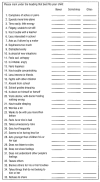Use of the Pediatric Symptom Checklist to screen for psychosocial problems in pediatric primary care: a national feasibility study
- PMID: 10086402
- PMCID: PMC3905751
- DOI: 10.1001/archpedi.153.3.254
Use of the Pediatric Symptom Checklist to screen for psychosocial problems in pediatric primary care: a national feasibility study
Abstract
Background: Routine use of a brief psychosocial screening instrument has been proposed as a means of improving recognition, management, and referral of children's psychosocial morbidity in primary care.
Objective: To assess the feasibility of routine psychosocial screening using the Pediatric Symptom Checklist (PSC) in pediatrics by using a brief version of the checklist in a large sample representative of the full range of pediatric practice settings in the United States and Canada. We evaluated large-scale screening and the performance of the PSC in detecting psychosocial problems by (1) determining whether the prevalence of psychosocial dysfunction identified by the PSC was consistent with findings in previous, smaller samples; (2) assessing whether the prevalence of positive PSC screening scores varied by population subgroups; and (3) determining whether the PSC was completed by a significant proportion of parents from all subgroups and settings.
Patients and methods: Twenty-one thousand sixty-five children between the ages of 4 and 15 years were seen in 2 large primary care networks: the Ambulatory Sentinel Practice Network and the Pediatric Research in Office Settings network, involving 395 pediatric and family practice clinicians in 44 states, Puerto Rico, and 4 Canadian provinces. Parents were asked to complete a brief questionnaire that included demographic information, history of mental health services, the 35-item PSC, and the number of pediatric visits within the past 6 months.
Results: The overall prevalence rates of psychosocial dysfunction as measured by the PSC in school-aged and preschool-aged pediatric outpatients (13% and 10%, respectively) were nearly identical to the rates that had been reported in several smaller samples (12%-14% among school-aged children and 7%-14% among preschoolers). Consistent with previous findings, children from low-income families were twice as likely to be scored as dysfunctional on the PSC than were children from higher-income families. Similarly, children from single-parent as opposed to those from 2-parent families and children with a past history of mental health services showed an elevated risk of psychosocial impairment. The current study was the first to demonstrate a 50% increase in risk of impairment for male children. The overall rate of completed forms was 97%, well within an acceptable range, and at least 94% of the parents in each sociodemographic subgroup completed the PSC form.
Conclusions: Use of the PSC offers an approach to the recognition of psychosocial dysfunction that is sufficiently consistent across groups and locales to become part of comprehensive pediatric care in virtually all outpatient settings. In addition to its clinical utility, the consistency and widespread acceptability of the PSC make it well suited for the next generation of pediatric mental health services research, which can address whether earlier recognition of and intervention for psychosocial problems in pediatrics will lead to cost-effective outcomes.
References
-
- Haggerty RJ, Roghmann KJ, Pless IB, editors. Child Health and the Community. New York, NY: John Wiley & Sons; 1975.
-
- Kelleher KJ, Wolraich ML. Diagnosing psychosocial problems. Pediatrics. 1995;95:899–901. - PubMed
-
- Costello EJ, Edelbrock C, Costello AJ, Dulcan MK, Burns BJ, Brent D. Psycho-pathology in pediatric primary care: the new hidden morbidity. Pediatrics. 1988;82:415–424. - PubMed
-
- Brandenburg NA, Friedman RM, Silver SE. The epidemiology of childhood psychiatric disorders: prevalence findings from recent studies. J Am Acad Child Adolesc Psychiatry. 1990;29:76–83. - PubMed
-
- National Institute of Mental Health. National Plan for Research on Child and Adolescent Mental Disorders. Rockville, Md: National Institute of Menial Health; 1990.
Publication types
MeSH terms
Grants and funding
LinkOut - more resources
Full Text Sources
Medical
Miscellaneous


